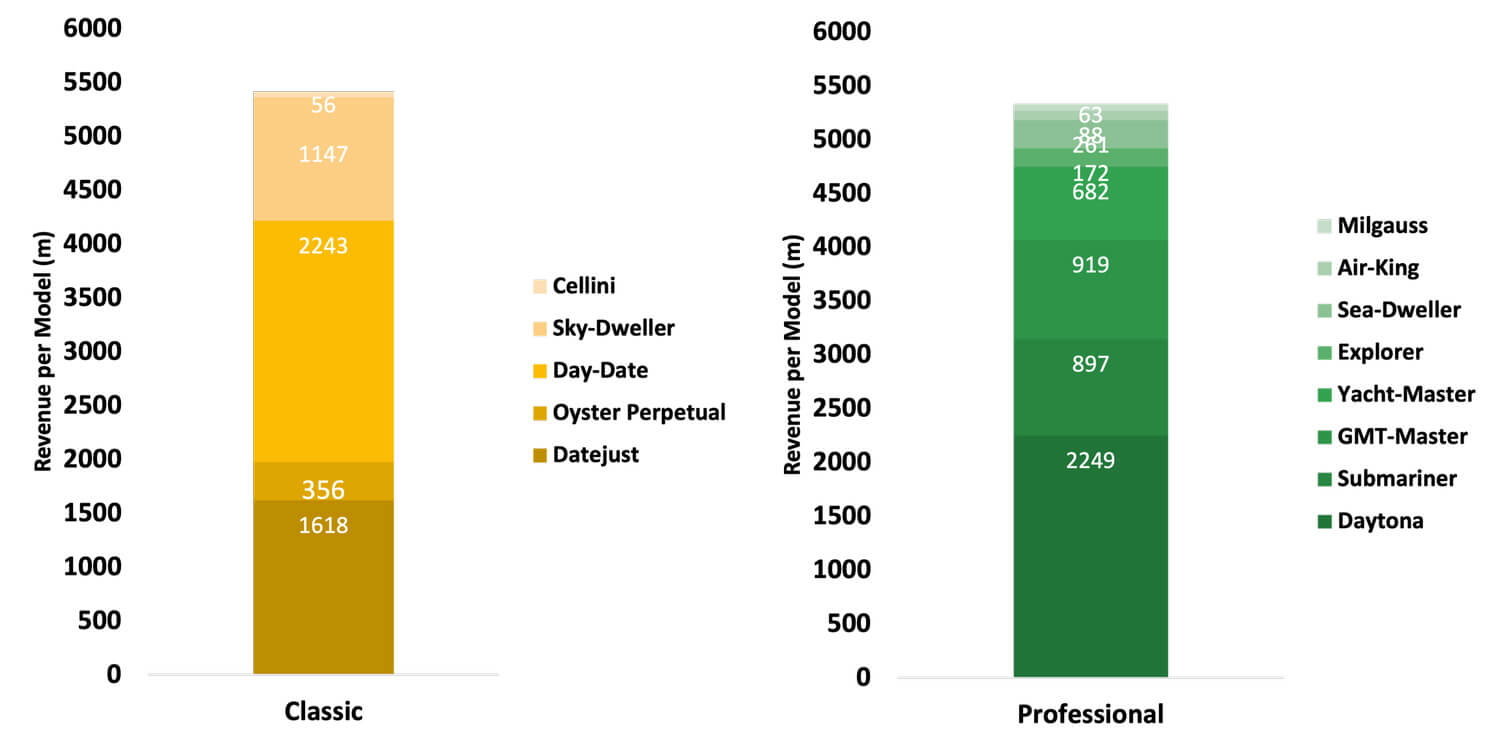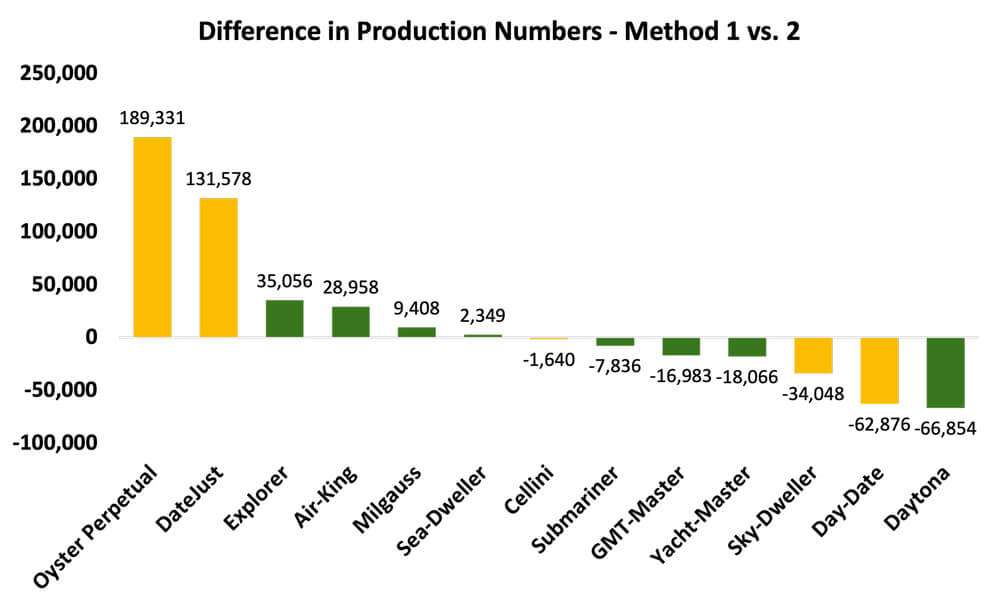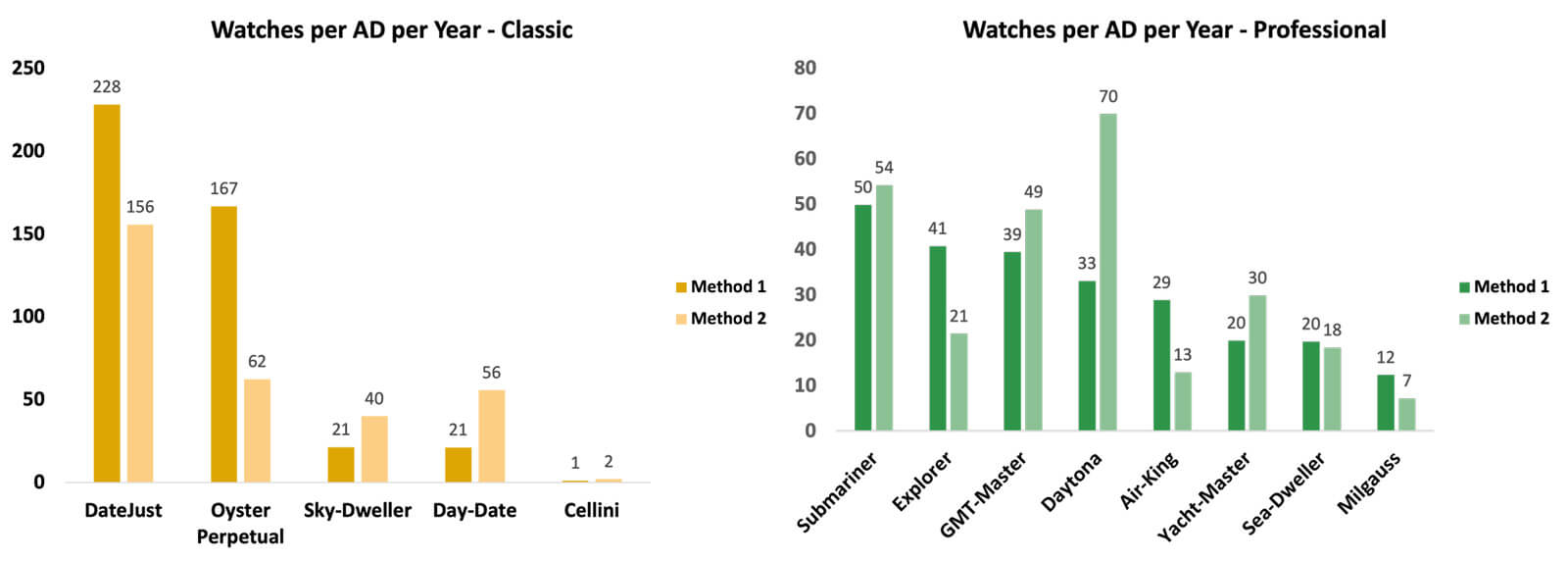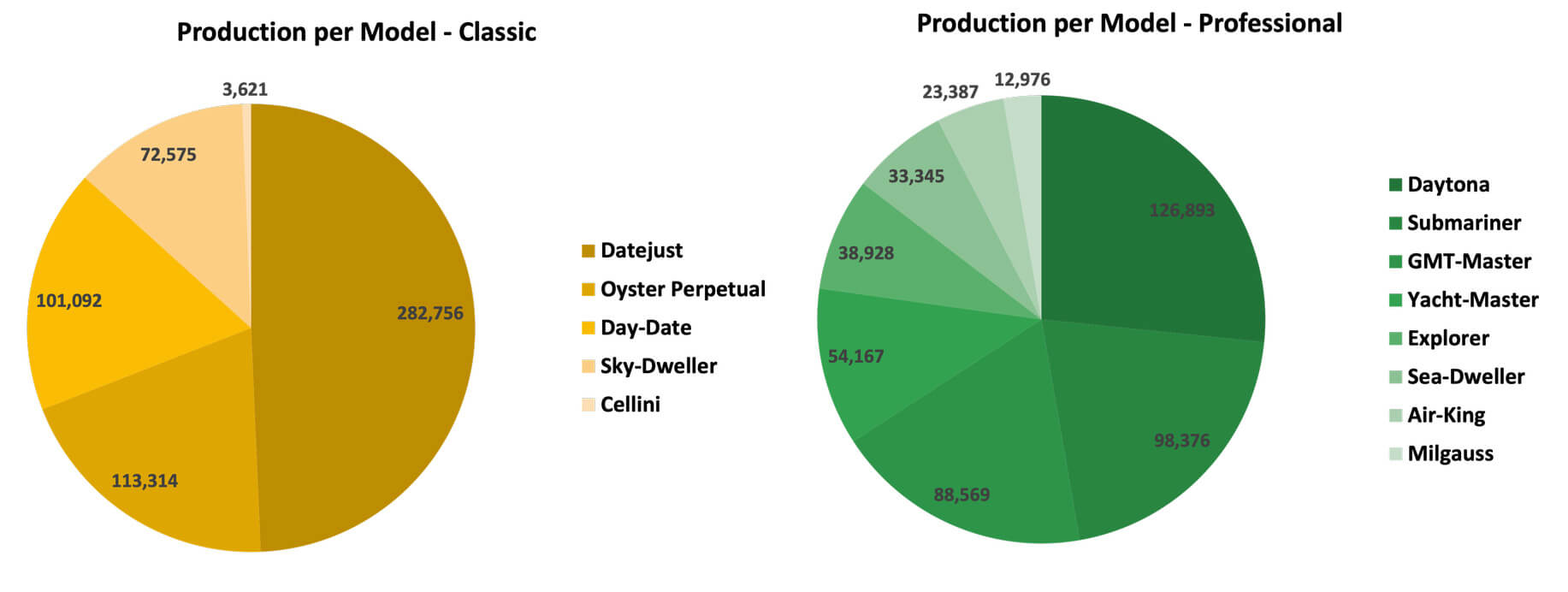—————————————————————————————————–
Revenue and Production Numbers – Method 2
The second of the two methods assumes that the production number of 1.05 million watches per year is correct. With this being the case, we can apply the Chrono24 proportions discussed earlier and visualize how many of each model are produced.
Estimated production numbers of Rolex Classic and Professional models using Method 2
Looking at the figures here, the numbers are still large, even if less than Method 1. There are roughly 575k Classic models produced, of which, nearly half are the Datejust alone. To put this into context, it is estimated that Omega produces half a million watches a year (BQWatches). It is known Rolex is large, but now with this in mind, the extent of just how enormous Rolex becomes clear.
Looking at a few popular models in more depth, the Submariner accounts for just over 98k watches a year and within that just under 60k are stainless steel versions. The remainder is equally split between the two-tone and gold variants. The GMT-Master is somewhat similar. Overall, 88.5k are produced a year, with the stainless steel model accounting for around 54k.
For the balance, the GMT-Master sees a higher proportion of gold models when compared to the two-tone. The final example to consider is the Daytona. As we saw earlier, the Daytona accounts for a higher proportion than the Submariner and GMT-Master, but when breaking it down, the gold references make up the majority.
The coveted stainless steel Daytonas only account for around a third of the gold references. But keep in mind that there are only two stainless steel references.
Assuming that the production number of 1.05 million watches a year and the amount per model is correct, what does this mean for revenue? Using the same weighted average retail price of each model and corresponding wholesale prices, we can find out.

Estimated revenues of Rolex Classic and Professional models using Method 2
The most significant outcome is the top-line revenue is $10.75 billion – this is $2 billion more than the figure from Statista. Moving to the next level, the revenue generated by the Professional and Classic collections is a lot closer. This is being driven by the Professional side, more specifically, the Daytona and Yacht-Master thanks to higher wholesale prices.
The Daytona accounts for $2.25 billion in this method. The GMT-Master is also affected and generates over $900 million. This results in the GMT-Master producing more revenue than the Submariner, contrasting with what was seen in the previous method.
On the other hand, the revenue from the Air-King, Explorer and Milgauss is significantly lower. Moving to the Classic watches, the Datejust accounts for $1.6 billion. Still an astronomical number, but lower than in Method 1, and offset by a large increase in revenue from the Day-Date.
These numbers, as touched upon with the Daytona and Yacht-Master, are all driven by wholesale price levels. Those watches with a higher retail price have a greater wholesale price and this is the number used in calculating revenues. This can be clearly seen when considering the Day-Date.
Number of Watches per Authorized Dealer
Finally, with these supply figures we can estimate one more metric – the number of watches each Authorized Dealer receives a year. In 2022, Millenary Watches calculates that there are 1816 ADs globally (2022 AD numbers vs. 2021 production so a small margin of error here).

Difference in Rolex production estimates between Method 1 and Method 2
As we saw above, the two methods provide us with differing estimates of production numbers across models. Before getting to the watches per AD, you can see on the chart the difference in production values calculated between Method 1 and 2. The biggest driver here is those models that have a lower wholesale price need to be more supplied by Rolex to generate the corresponding revenue proportions. Below you can see this difference and it will become clear.
Now that we can easily see the variation between the two methods and understand why it is the case, we can find the corresponding number of watches per AD for both. Spoiler – this just reinforces how few each store receives a year!
Focusing on Method 1 to start (assuming the revenue value is correct). On average, each store will receive 244 Professional watches, nearly double that in Classic. Only 33 Daytonas reach each AD, and only half of the retailers globally will receive 1 platinum Daytona each year.
Despite the relatively few references, the Submariner is one of the more supplied models, even more so than the GMT-Master. Surprisingly, even the Explorer I & II is more supplied than the GMT-Master. This results from the lower wholesale value of the Explorer range meaning more watches need to be supplied as mentioned above.

Estimated numbers of Rolex models delivered to authorized dealers
Moving to the results for Method 2 (assuming the production value is correct). Each AD would receive 262 Professional models a year, only slightly more than Method 1, however, ADs only receive 316 Classic models. This is much lower than the number just above, driven by far fewer Datejust and Oyster Perpetuals offset by a small increase in Day-Date references.
In the Professional collection, this can also be seen, although the changes result in only a minor divergence in the total line. There are double the Daytonas making their way into ADs compared to Method 1 but nearly half the Explorers. This is because the wholesale value of models is not taken into account in calculating the production, but rather, solely the Chrono24 proportions.
I do want to acknowledge that these are just averages. Not every Rolex AD is equal. There may be regions or cities where specific models tend to be more supplied given consumer trends. Likewise, if you have a large Rolex AD such as the London Knightsbridge location, I imagine more watches make their way here compared to a small branch in a less populated town.
Again, I have no specific information on how this works, but it would be logical that not every branch received the same allocation.
—————————————————————————————————–
Credit: Source link
